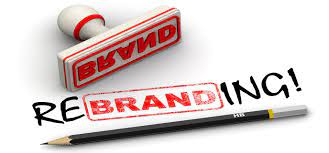What elements must be present in a rebranding strategy to be effective? To what extent can you anticipate success with this method? What do the outcomes look like? This article will help you find the answers to these and other questions as you consider revitalizing the brand of your professional services company. Although every company is unique, a few tried-and-true rebranding ideas may be implemented by businesses of any size, in every industry. Branding is rarely considered at the beginning of a new venture. After all, with everything else going on, it’s tough to take the time to sit down and browse fonts. Whether you started with a paper logo and finished with a whiteboard, things stopped working at some point. As we go further in this article, we’ll look at some practical rebranding examples and a checklist.
What is Rebranding?
Rebranding is a marketing approach that involves modifying an existing corporate identity by creating a new brand name, symbol, logo, and other visual assets. However, the purpose of rebranding is to give a company a new and distinct identity in the eyes of its target audience, which can include customers, investors, prospects, competitors, and even current and prospective staff.
Furthermore, business veterans realize the importance of brand identity when they launch a new venture. They are also aware that it is only through strategic decision-making and not leaving branding to chance that a company can establish a recognizable and respected brand.
Newer business owners sometimes need help to recognize the importance of branding fully. It is a common misconception among business owners and entrepreneurs that the company’s name and logo are the only identifying brand features. Business names and logos are the front lines of promotion for any company, therefore they need to be memorable and influential.
A brand, however, is more than just its name and logo. The sum total of the impressions made on current and potential customers by your business is its brand.
You can tell what your firm does and how it does it through its brand. Customers and potential buyers will have more faith and confidence in your business if your brand is strong. Also, if you don’t put in the time and effort to craft a solid brand identity from the get-go, it can end up working against you and your company’s expansion ambitions.
In case your company is experiencing similar difficulties, you are not alone. Investors and banks will examine your company plan and visual marketing materials to determine if you appreciate the importance of good design and branding.
What Are the Types of Rebranding?
Knowing the different types of rebranding is essential if your small business is considering one. Learning about the various rebranding methods can assist you in choosing between a light refresh and a complete overhaul. So, here are the major types of rebranding you can consider:
#1. Total Rebranding
For a total rebrand, the old brand must be utterly obliterated, and a new one constructed from scratch. Perhaps there was a significant shift in leadership, or perhaps you are entering a new market. A total rebranding is time-consuming regardless of the chosen approach.
Do this only when absolutely required, such as if you find that you are not resonating with your intended audience. Moreover, if you can’t establish meaningful relationships with your target demographic, a complete rebranding may be in order.
#2. Brand Merger or Acquisition
Combining two separate brands into one is an example of this style of rebranding. After an acquisition, both companies’ identities and their brands will change. For a brand merger to work, it’s important that the two brands are complementary to one another. On the other hand, sometimes it makes more sense to rebrand in order to merge the two businesses completely. Keep in mind that a complete rebranding may take a longer time.
#3. Brand Refresh
A brand refresh can consist of anything from a basic logo redesign to a complete rethinking of the company’s purpose. While this is significantly less work than starting from scratch with a new brand identity, it still necessitates a redesign of your logo, stationery, website, and any other visual assets you currently have in circulation.
What Is the Purpose of Rebranding?
A rebranding effort may be conducted by a company for a variety of reasons, including a merger and acquisition (M&A) or the introduction of a new product line; however, the driving force behind such an endeavor is typically the requirement to forge a deeper connection between the product and identity of the brand and the audiences that it seeks to attract. The goods that a company sells, the customers it targets, and the industry in which it competes are all subject to unavoidable and potentially substantial change over the course of its existence.
The process of rebranding a company can be a difficult and costly endeavor, but when it is done well, it has the ability to better differentiate organizations from their competitors and to connect more closely with the desires, requirements, and values of its consumers. Because of the rapid pace at which change occurs in today’s digital marketplace, an increasing number of today’s organizations are engaging in rebranding efforts in order to maintain their position as market leaders.
Read Also: CO-BRANDING: Definition and Real-World Examples
Rebranding Examples
There is beauty in a successful rebranding effort and ideas. When a company takes the time to examine its core principles, refine its messaging, and update its visual identity to reflect these changes, the end result is potent. Of course, this isn’t a simple endeavor, which is why it’s encouraging to see a rebranding effort executed well and why we enjoy recognizing outstanding efforts when we come across them.
Whether you’re in the market for a rebranding case study or you just enjoy a good before-and-after, you’ll find that these wildly different companies have found the sweet spot by honing their messages, enhancing their visuals, and bolstering their brand experience on every front. The goal of these rebranding examples is to get you to question and reimagine your own brand strategy. So, here are the top 5 rebranding examples.
#1. Coty by Workroom
Throughout its rebranding process, Coty made its mission—”to celebrate and free the multiplicity of beauty”—a focal point. Workroom, a branding agency, recently underwent a significant aesthetic renovation and decided to take its cue from the butterfly, a symbol of the infinite variety of natural (and human) beauty.
An elaborate visual language was used, full of colorful, striking imagery that consistently referenced butterflies. Coty Sans, a unique font, was created with “special curves reflecting a butterfly’s symmetry.”
#2. ACLU by Open
“To defend and maintain the individual rights and liberties granted to every person in this country by the Constitution and laws of the United States” is the stated goal of the American Civil Liberties Union.
They wanted to send a message of national unity and acceptance, so they abandoned their traditional blue logo (which was seen as a partisan statement) in favor of a color scheme that included blue, red, and… everything (14 colors to be exact). The ACLU’s disability rights staff was consulted to ensure that the materials’ color palette and font size met the needs of all readers.
#3. Tupperware by FutureBrand
The term “Tupperware” generally makes people think of housewives from the 1970s. Instead of trying to hide it, the company has embraced the negative connotation as an integral part of its history and overall purpose. They aren’t just about the packaging; they’re also about giving back to the women entrepreneurs who bring their wares to market. Their newfound self-assurance became the slogan for their rebranding campaign.
Their radical redesign brought the brand into the modern era by using bright colors, human-centered images, and a more streamlined look.
#4. DXC Technology
A merger is one of the most common causes of rebranding. Nonetheless, it also represents one of the greatest difficulties. When Computer Sciences Corporation and Hewlett Packard Enterprise’s Enterprise Services division joined to form DXC, a complete branding was necessary to bring the two companies together.
Due to its status as the most prominent independent, end-to-end IT services provider worldwide, the brand’s identity centers on the company’s stated purpose: “to assist clients in achieving their goals in the face of accelerating innovation.” The identity, reflecting this aggressive and authoritative tone, helps to establish the company as a frontrunner in this dynamic sector.
#5. PNG AIR by Principals
PNG Air is a Papua New Guinean airline. The company, formerly known as Airlines PNG, underwent a complete rebranding effort that saw it change its name, positioning, and visual identity. The mission was to transform the airline from a faceless, price-focused commodity into a distinctive, market-leading brand.
To achieve this, the brand’s Principals used a visual motif of key cultural icons, paying honor to the company’s heritage, nation, and brand promise: to serve their people.
Read Also: BRAND ARCHITECTURE: Definition, Models, and Examples
What Are the 4 Steps of Branding?
Creating a memorable brand that appeals to both current and potential buyers is no easy task. Whilst it may seem daunting at first, developing a brand is actually rather simple if you put in the time and effort and have a firm grasp on what your target demographic is interested in, and requires, and how you can meet those desires. To make things easier, here are the 4 steps of successful branding.
#1. Determine Who You’re Trying to Reach
Branding begins with identifying your ideal customer. To attract your ideal customers, you should:
- Target the people who are most likely to buy the product: Create a demographic by thinking about things like age, gender, geography, and income, among others. Middle-to-high-income earners under the age of 40 may be a good fit if you’re marketing high-end eyewear to the public. In contrast, athletes are likely to have an interest in your new sports drink.
- Research the current sales numbers that are out there: You can learn a great deal about consumers’ shopping patterns from this data. Using demographic data, a business can gauge whether or not a given customer base will buy a given product. The generation born between 1980 and 2000 may be the most price-conscious generation yet, and they may also like making purchases online. You can conduct your own surveys to collect the necessary statistics, or you can hire a marketing organization to do it.
- Discuss your product or service with your audience: Communicate with people that represent the profile of your ideal customer so you can learn more about their wants and requirements and the products that resonate with them. A more precise plan for satisfying your client’s needs can be drawn out.
- Look into other businesses like it: Successful providers of comparable goods or services might provide a valuable source of information. Determine how they come up with their marketing efforts, especially those that appeal to your target demographic. Evaluate the brands of various companies by comparing their data.
#2. Find the Right Spot for Your Company and Its Products
The process of positioning a company is identifying what sets its products and services apart from competitors. Before you can effectively compete with your direct competitors, you need to learn as much as possible about them. This includes studying their products, prices, target customers, and marketing approaches. Think about what you could do better than them, and take advantage of any gaps in the market that their offerings may have.
A distinct selling offer should be created following a thorough examination of the competitors. A unique selling proposition (USP) is a one- or two-sentence description of the product or service that a business provides. Also, your unique selling proposition (USP) should emphasize your product’s special qualities and the benefits it offers to customers.
#3. Establish the Essence of Your Business
In many ways, a company’s brand is synonymous with its identity. Identifying the company’s core values and culture is, therefore, crucial to the branding process. A company’s character can be shaped not just by the goods and services it offers, but also by the people who buy them. Active personas are probably the way to go if you’re hoping to appeal to cyclists.
Defining your company’s character will need some imaginative teamwork on the part of all of the brand’s stakeholders. Start by imagining the business as a person. You could, for instance, provide a physical and behavioral description of the firm if it were a hiker. You and the rebranding team will have an easier time putting your ideas and strategy into words if you use concrete examples of them, such as “traveler,” “independent,” “revolutionary,” or “fun.”
Also, the same goes for your brand or product, which you can try to identify with anything. If, for instance, the company makes running shoes, you might picture a gazelle and build from there.
With these kinds of original ideas, you and your team will be able to give your firm a voice of its own.
#4. Choose an Emblem and a Catchphrase
An eye-catching logo can increase brand recognition, and a memorable tagline can increase sales.
The values of your organization should reflect your brand. It is important to promote your brand internally by maintaining a consistent image across all channels, including your appearance, voice, and demeanor in the workplace. However, your actions will serve as an example for your coworkers, and may even influence the culture of the firm as a whole.
Rebranding Strategy
Determine whether your brand ideas are a minor facelift or a complete overhaul before you dive into a rebranding strategy. The next step in rebranding is to redefine your brand’s target market by conducting research to determine who it is you want to reach. You should also update your company’s strategic plan to reflect the newly defined vision, mission, and values. Your rebranding ideas and strategy may include.
#1. The Business Plan Should Come First
To develop a successful rebranding strategy, one must first have a firm grasp on the business priority driving the effort. Is the impetus to quicken expansion necessary? Is your company going to have to compete with other, larger businesses?
Merging two companies is one example of a business case that is quite straightforward to develop. Alternatively, there are more nebulous causes, such as just outgrowing your image. It’s easy to waste a lot of time and money if you don’t know what’s in it for the business. Just to name a few more convincing reasons for rebranding the strategy of your professional services company:
- You have to compete more effectively or enter another market.
- You can’t even trust your own brand anymore.
- Simplify and hone in on your message.
- If you don’t make the adjustment, the law may force you to.
#2. Examine Your Company and Its Prospective Customers
When the financial justification for a rebranding has been established, the next step is to perform impartial market and customer research. Including potential customers from the new market you’re breaking into is an important part of any market analysis. In addition, you need an unbiased look at how your brand is now perceived and how well it performs.
If you don’t do this study, you’ll be limited to your own thoughts and feelings in your decision-making. Our analysis of the buying and selling of professional services reveals that nearly every company has blind spots that affect its image in the market. We have a common humanity, after all. You can’t construct a reputable brand on assumptions without first conducting a thorough investigation.
#3. Capture Your Brand’s Strategy Through Strategic Positioning and Messaging
Creating your company’s market positioning and messaging framework is where your brand strategy really begins to take shape. In the business world, your “market positioning” is a quick explanation of how and where you stand in relation to competitors. Is your company known for cutting costs or groundbreaking new ideas?
Much of your future choices will be based on this positioning. Nevertheless, you can’t just make anything up. You need to strike a balance between your current identity and your desired future. A brand is only as strong as its ability to deliver on its positioning.
All of your primary target demographics will receive specific messages thanks to your carefully crafted messaging architecture. These assertions must be consistent with your brand’s values by data. In addition, this is not advertising language. It provides the framework for the rest of the advertising copy.
#4. Create a Name for Your Company
In this stage of the rebranding process, you create the graphics that will represent your brand. Consider things like the company’s name (if any), logo, tagline, colors, business card design, and stationery. In order to maintain cohesion throughout all of your advertising pieces, it is common practice to detail all of these aspects in a brand style standards document.
People often mistake these for part of your brand. What makes a company memorable is not its name or logo, but rather the way it is perceived by consumers. Logos, slogans, and other identifying features all contribute to your brand’s identity. Also, read BRAND STRATEGY: Definition, Examples & Components of Branding.
#5. Develop Your Online Identity by Creating a Website
When it comes to spreading your message and expanding your business, your website is vital. It’s where you can captivate each of your target demographics with an engaging narrative. To find out more about your company, potential customers and employees will look there first.
A website and a strong online presence are vital to the success of any 21st-century professional services organization. You will need to update your website as part of any successful rebranding strategy. A website, in essence, is based on the structure of your messaging architecture. You can’t fully communicate your positioning without it and the rest of your online presence (via channels like social media, for instance).
Rebranding Checklist
Customers and other stakeholders will be more loyal to your organization if they have positive associations with it. Despite this, with so many different marketing communication channels available today, a rebranding checklist and ideas remain one of the most challenging marketing pushes a firm can undertake.
The next step after developing a brand that resonates with your target audience is to put it into action. Your hard work should not be wasted on a botched brand launch due to simple oversights like keeping the previous email footer or not updating the social network usernames.
There is only one opportunity to implement a rebranding checklist and strategy across all channels. So, here are rebranding checklist for businesses.
#1. Visual
These are the three key questions to ask while conducting a brand refresh and reevaluating your organization’s vision, mission, and core values. It’s easy to become complacent with the roots of your messaging, yet these might shift as your company develops.
When rebranding, it’s important to put in the time and effort to develop a unique and effective strategy for the aesthetic elements. Making sure that every visual aspect of the rebrand is captured is what will ensure that it is remembered by the target audience.
#2. Changing Your Company’s Name Is Part of a Rebranding
Changing your company’s name is a major step that can have a negative impact on your visibility in search engine results and the loyalty of your customers. For this reason, it is important to have a post-rebranding strategy in place, including a plan for recovery, if you are changing your company’s name.
If your name is still appropriate, it is usually advisable to keep using it. Yet, if your present name does not reflect your company’s character, you may need to start over. Here are some suggestions to get you started on the onerous task of renaming:
- change the spelling of a word
- Figure out a way to abbreviate the phrase.
- Put in the name of a place
- Create a brand-new neologism
- Incorporate a dated term into a novel context
- Put it out there (literally)
During a rebranding checklist, it’s important to reconsider your company name with an eye toward how well it reflects the brand’s values, vision, and mission, rather than how catchy it could be. Your new name will have a better chance of helping you achieve your long-term ambitions if you do this.
#3. Website
Whenever you do a brand refresh, you’ll also need to update your website. See to it that your brand’s visual elements (such as typography, iconography, updated messaging, and logos) all work together to convey the message you intend. Changing your domain name is just the beginning of the work involved in a complete rebranding. All of the old URLs should be redirected to the new URLs using a 301 redirect.
All of your live landing pages should also be brought up to date. Also, to avoid misleading consumers or causing them to lose trust in your brand, it is essential that you update all graphic elements and verbiage to reflect the new identity. This is a perfect rebranding checklist.
Conclusion
Now that you are aware of everything that is involved in rebranding strategy and ideas, it is time to decide whether or not you want to rebrand your own firm and, if so, how you want to go about doing so. These steps can help you explore your best plan for developing a brand that gets it right this time, regardless of whether you decide to revamp your logo, your website, your messaging, or completely rebuild your brand.
Rebranding FAQs
What are the 3 rules of branding?
- Creativity
- Be Consistent
- Be Connected
What are the 3 Cs of branding?
Communicating your brand’s message effectively takes time and effort. Keep in mind that you want your brand’s positive impression to come through clearly in any language. So, use the “3 Cs” approach of brand messaging to effectively convey your brand’s message and values.
- Consistency
- Clarity
- Character
Similar Articles
- GREEN MARKETING: The A-Z Guide (+ Practical Examples)
- HOW TO CREATE A BRAND 2023 Guide (+ Free Tips)
- BRAND IDENTITY: How To Build a Strong Brand Identity
- Visual Voicemail: How Does It Work, And What Are The Benefits?
- PROGRAMMATIC ADVERTISING: Meaning, Examples & Benefits






